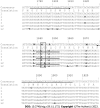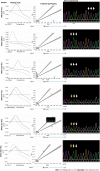Locked nucleic acid real-time polymerase chain reaction method identifying two polymorphisms of hepatitis B virus genotype C2 infections, rt269L and rt269I
- PMID: 37077521
- PMCID: PMC10107212
- DOI: 10.3748/wjg.v29.i11.1721
Locked nucleic acid real-time polymerase chain reaction method identifying two polymorphisms of hepatitis B virus genotype C2 infections, rt269L and rt269I
Abstract
Background: The presence of two distinct hepatitis B virus (HBV) Pol RT polymorphisms, rt269L and rt269I, could contribute to the unique clinical or virological phenotype of HBV genotype C2. Therefore, a simple and sensitive method capable of identifying both types in chronic hepatitis B (CHB) patients infected with genotype C2 should be developed.
Aim: To develop a novel simple and sensitive locked nucleic acid (LNA)-real time-polymerase chain reaction (RT-PCR) method capable of identifying two rt269 types in CHB genotype C2 patients.
Methods: We designed proper primer and probe sets for LNA-RT-PCR for the separation of rt269 types. Using synthesized DNAs of the wild type and variant forms, melting temperature analysis, detection sensitivity, and endpoint genotyping for LNA-RT-PCR were performed. The developed LNA-RT-PCR method was applied to a total of 94 CHB patients of genotype C2 for the identification of two rt269 polymorphisms, and these results were compared with those obtained by a direct sequencing protocol.
Results: The LNA-RT-PCR method could identify two rt269L and rt269I polymorphisms of three genotypes, two rt269L types ['L1' (WT) and 'L2'] and one rt269I type ('I') in single (63 samples, 72.4%) or mixed forms (24 samples, 27.6%) in 87 (92.6% sensitivity) of 94 samples from Korean CHB patients. When the results were compared with those obtained by the direct sequencing protocol, the LNA-RT-PCR method showed the same results in all but one of 87 positive detected samples (98.9% specificity).
Conclusion: The newly developed LNA-RT-PCR method could identify two rt269 polymorphisms, rt269L and rt269I, in CHB patients with genotype C2 infections. This method could be effectively used for the understanding of disease progression in genotype C2 endemic areas.
Keywords: Chronic hepatitis B; Genotype C2; Hepatitis B virus; Locked nucleic acid-real time-polymerase chain reaction; Polymerase; rt269.
©The Author(s) 2023. Published by Baishideng Publishing Group Inc. All rights reserved.
Conflict of interest statement
Conflict-of-interest statement: All the authors report no relevant conflicts of interest for this article.
Figures




Similar articles
-
Distinct phylogeographic distributions and frequencies of precore and basal core promoter mutations between HBV subgenotype C1 rt269L and rt269I types.Sci Rep. 2025 Mar 18;15(1):9315. doi: 10.1038/s41598-025-94286-6. Sci Rep. 2025. PMID: 40102552 Free PMC article.
-
rt269I Type of Hepatitis B Virus (HBV) Polymerase versus rt269L Is More Prone to Mutations within HBV Genome in Chronic Patients Infected with Genotype C2: Evidence from Analysis of Full HBV Genotype C2 Genome.Microorganisms. 2021 Mar 15;9(3):601. doi: 10.3390/microorganisms9030601. Microorganisms. 2021. PMID: 33803998 Free PMC article.
-
rt269I Type of Hepatitis B Virus (HBV) Leads to HBV e Antigen Negative Infections and Liver Disease Progression via Mitochondrial Stress Mediated Type I Interferon Production in Chronic Patients With Genotype C Infections.Front Immunol. 2019 Jul 24;10:1735. doi: 10.3389/fimmu.2019.01735. eCollection 2019. Front Immunol. 2019. PMID: 31402915 Free PMC article. Clinical Trial.
-
rt269L-Type hepatitis B virus (HBV) in genotype C infection leads to improved mitochondrial dynamics via the PERK-eIF2α-ATF4 axis in an HBx protein-dependent manner.Cell Mol Biol Lett. 2023 Mar 30;28(1):26. doi: 10.1186/s11658-023-00440-1. Cell Mol Biol Lett. 2023. PMID: 36997871 Free PMC article.
-
Tenofovir is a more suitable treatment than entecavir for chronic hepatitis B patients carrying naturally occurring rtM204I mutations.World J Gastroenterol. 2019 Sep 7;25(33):4985-4998. doi: 10.3748/wjg.v25.i33.4985. World J Gastroenterol. 2019. PMID: 31543688 Free PMC article.
Cited by
-
Distinct phylogeographic distributions and frequencies of precore and basal core promoter mutations between HBV subgenotype C1 rt269L and rt269I types.Sci Rep. 2025 Mar 18;15(1):9315. doi: 10.1038/s41598-025-94286-6. Sci Rep. 2025. PMID: 40102552 Free PMC article.
References
-
- Nannini P, Sokal EM. Hepatitis B: changing epidemiology and interventions. Arch Dis Child. 2017;102:676–680. - PubMed
-
- Abara WE, Qaseem A, Schillie S, McMahon BJ, Harris AM High Value Care Task Force of the American College of Physicians and the Centers for Disease Control and Prevention, Abraham GM, Centor R, DeLong DM, Gantzer HE, Horwitch CA, Humphrey LL, Jokela JA, Li JMW, Lohr RH, López AM, McLean RM. Hepatitis B Vaccination, Screening, and Linkage to Care: Best Practice Advice From the American College of Physicians and the Centers for Disease Control and Prevention. Ann Intern Med. 2017;167:794–804. - PubMed
-
- Yuen MF, Chen DS, Dusheiko GM, Janssen HLA, Lau DTY, Locarnini SA, Peters MG, Lai CL. Hepatitis B virus infection. Nat Rev Dis Primers. 2018;4:18035. - PubMed
MeSH terms
Substances
LinkOut - more resources
Full Text Sources
Miscellaneous

